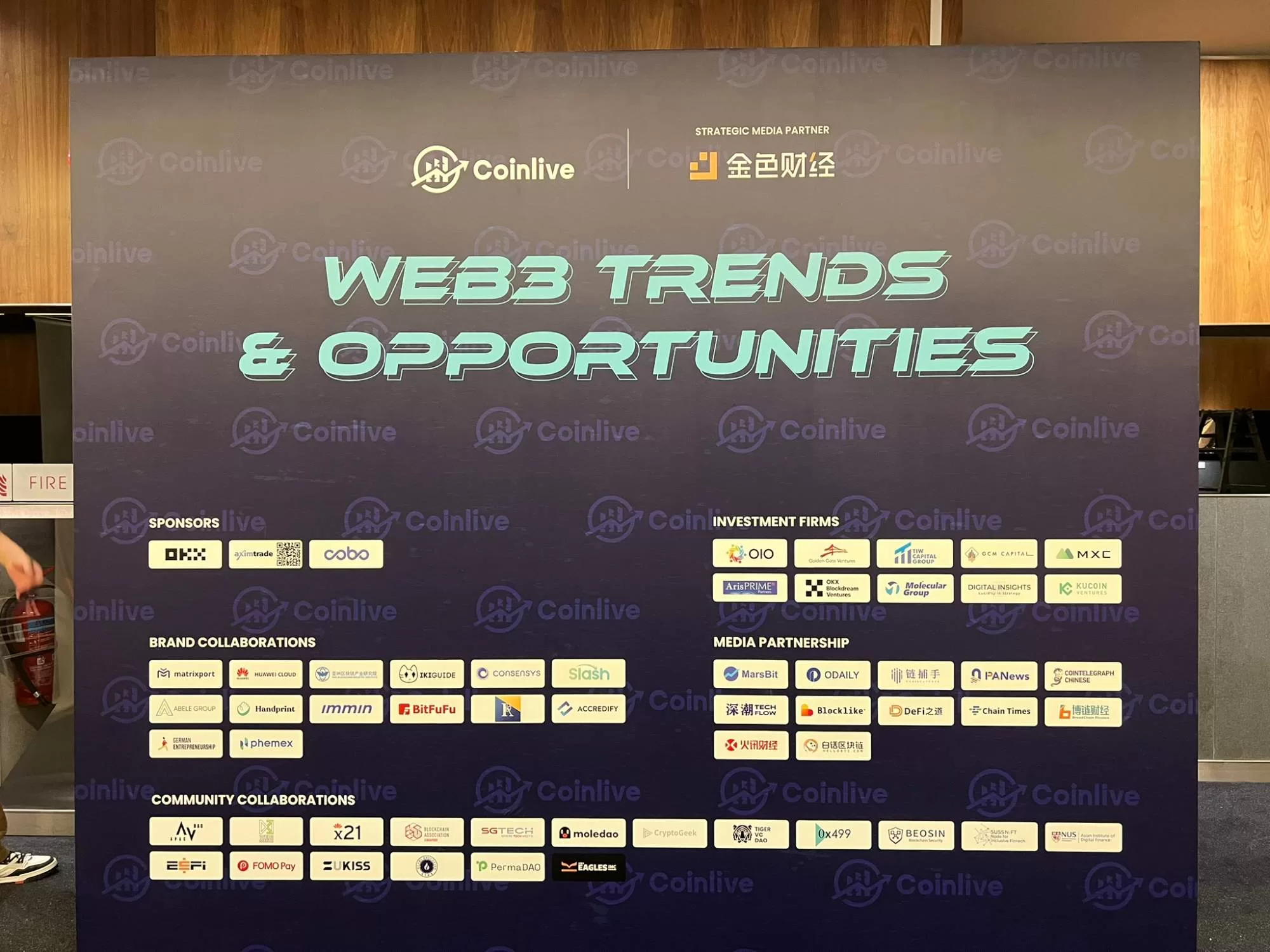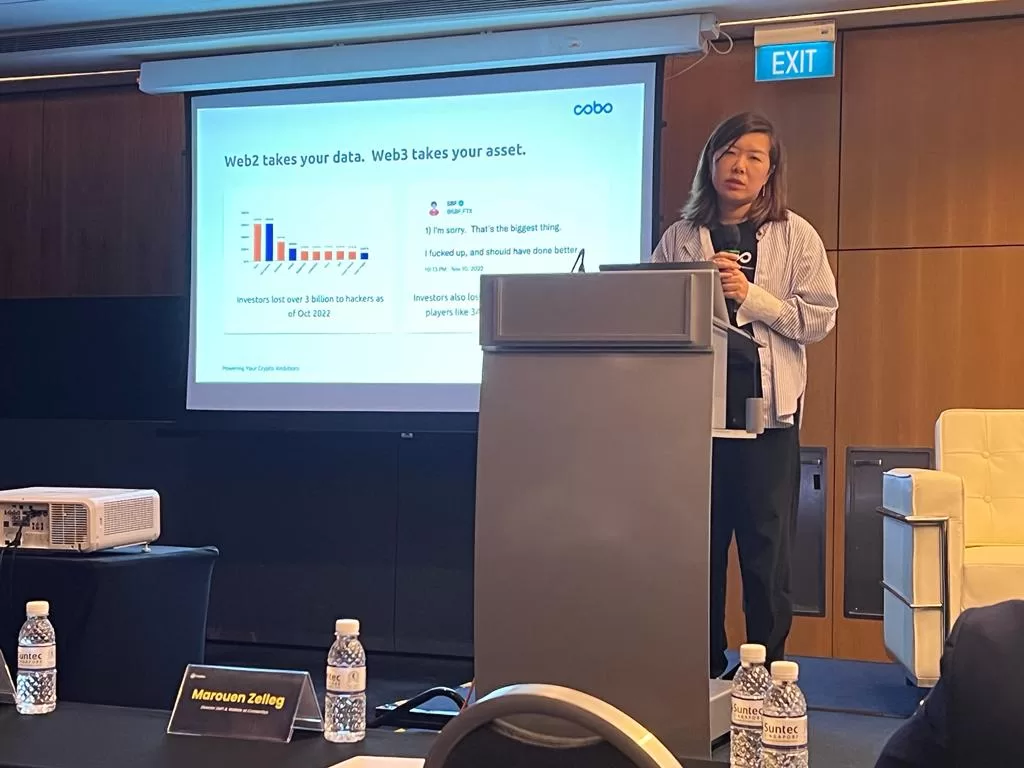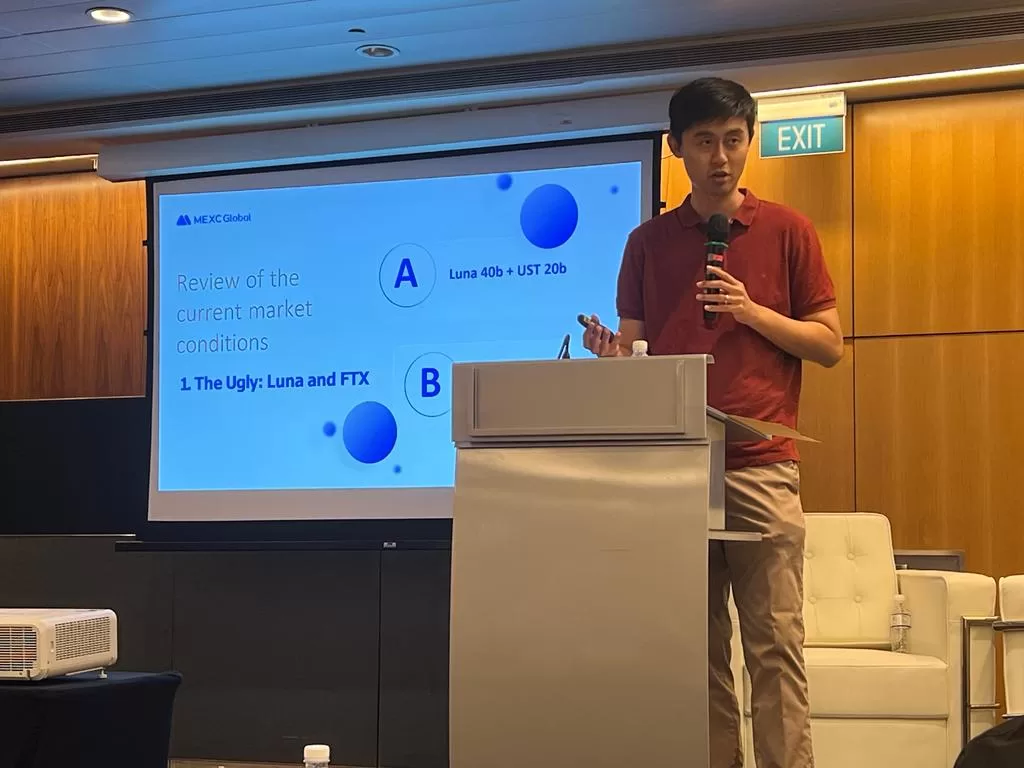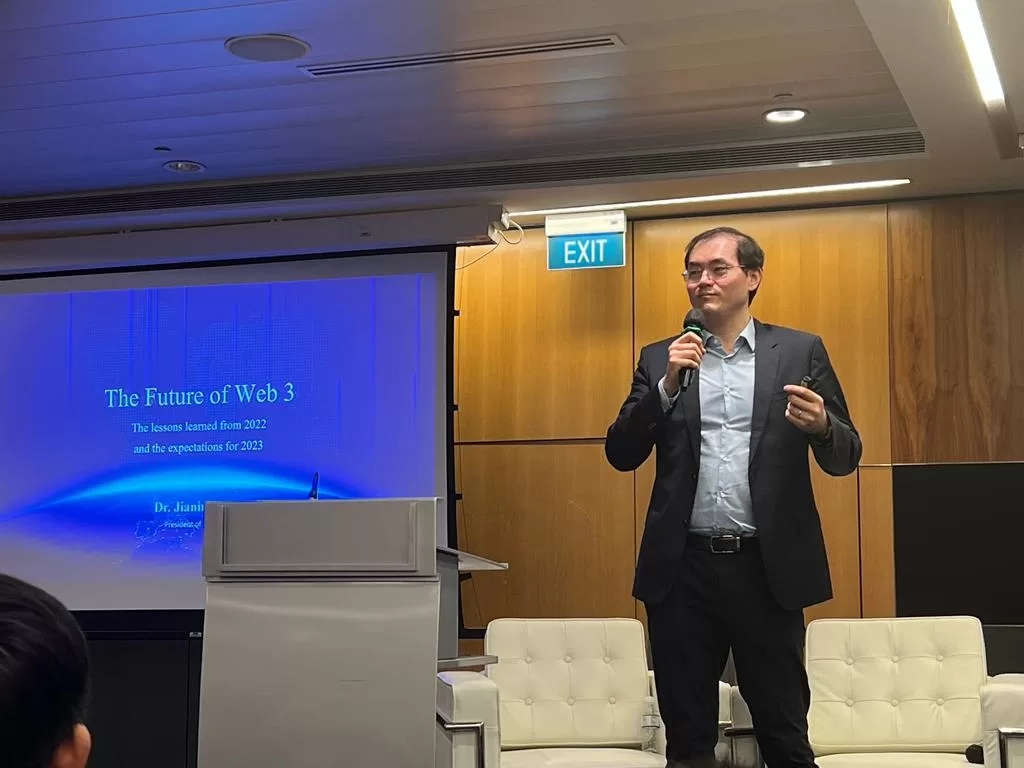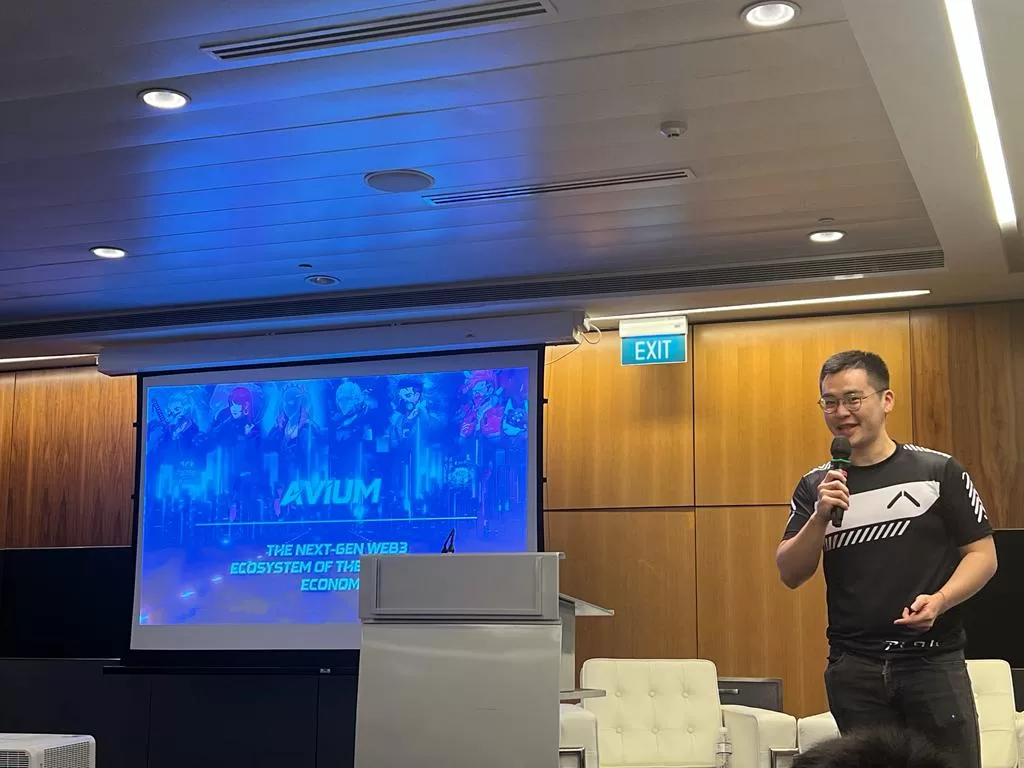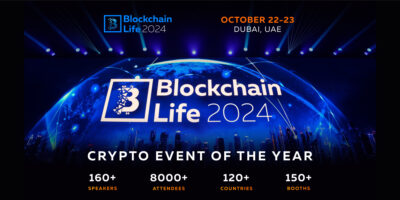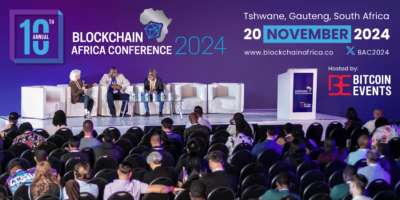Web3 Trends & Opportunities ─ The Web3 Transformation: What Awaits Us in the Future?
To end 2022 with a bang, Coinlive hosted its very own, as well as its very first grand-scale summit, at Suntec Convention & Exhibition Centre on 22 December. The full-day event featured keynote speeches by industry experts, insightful roundtable discussions, and a project pitch by a National University of Singapore (NUS) student. Like-minded individuals from all walks of life were present at the event to connect and gain valuable insights and key takeaways on Web3’s trends and opportunities, as well as what the future holds for it.
Web3 Trends & Opportunities ─ The Web3 Transformation: What Awaits Us in the Future? (Web3 and Artificial Intelligence (AI): Powering Tokenisation and Sustainability with Decentralised Technologies)
The very first speaker, Krishna Ramachandra, Founding Chairman of Sustainability & Impact Sub-Committee at Blockchain Association Singapore (BAS), as well as Founder of Digital Insights Ventures, kicks off the event with the first keynote speech touching on “Web3 and Artificial Intelligence (AI): Powering Tokenisation and Sustainability with Decentralised Technologies.”
He touched on some of the core principles that Digital Insights adopts which are interaction (user experience and exchange of data), interoperability (different communities and systems [C/S] work together and efficiency via shared resources and technology), integration (combination of different C/S and forming a collective community), and interlinked (ability to navigate seamlessly between related systems and co-dependency between C/S), and he likened it to their laws of engagement and said that these grounding principles are good to have.
“At the end of the day, you got to listen to what the community wants. If they ask for convenience, it is convenience – decentralisation. As much as you would like to beat the drum for the decentralisation movement, you still kind of have to listen to what the community wants. And I think this is sometimes missed on projects,” Krishna mentioned. He said the distinction of Web3 and Web3.0 are lost on a lot of people, and they are used interchangeably. “Web3.0 actually refers to the purest standpoint of having blockchain be the driver of preserving privacy and also giving sovereignty to your identity and data.
Meaning you will be able to control how your data is used; you would be able to monetise it,” he continued.
He expressed that the rules of engagement have to really take into account, sustainability. Krishna concluded his speech by stating that if people in positions of influence or power do not help the sustainability narrative, the true potential of Web3 would not be seen, which would be quite remarkable in the way it allows for the creator economy to flourish.
Web3 Trends & Opportunities ─ The Web3 Transformation: What Awaits Us in the Future? (The Metaverse & Asia: A New Era in Storytelling)
Soh Wan Wei, CEO at IKIGUIDE Metaverse Collective, took to the stage with her keynote speech titled “The Metaverse & Asia: A New Era in Storytelling”. She shared that the common thoughts of the metaverse is that is it Facebook or a game or a virtual world, and explained that you do not need to be afraid when you see words like AR, VR, XR, or MR as they are just technologies by which the metaverse can be executed. She listed down the three fundamentals in the metaverse:
1) Needs to be immersive: you are aware and conscious that you are in another reality
2) Interactive: there are activities to be done on the metaverse; it is not aimless
3) Social: community is at the core of every single metaverse we see
Wan Wei pointed out that she encountered questions like is the metaverse just a hype or is it the future and is here to stay. She went on to showcase some case studies she spotted on her recent trip to Japan, one of which is a project by a café called “Tree” by “Naked” in Yoyogi Park ─ diners don a VR headset for their fine dining experience; when one eats, there will be lights, sounds, and sensations around them to enhance and help you understand the story behind the food (it combines technology art such as VR and projection mapping with cuisine).
Another example is SK-II and the metaverse; “SK-II is a very progressive and they actually have their own SK-II city two years ago featuring Shibuya Crossing with six clips and films…instead of watching the movie just like that, you go into the metaverse and your avatar watches the movie. All these clips are actually in an avatar version,” she described.
The last example she showcased was of TeamLab: there is a space in Roppongi where you can step into the sauna to enjoy the metaverse sensation, and the idea is to alternate between extreme hot and cold in terms of sensation to tell you a story about life and philosophy.
“Asia will unveil a new era in storytelling through the metaverse,” she concluded.
Web3 Trends & Opportunities ─ The Web3 Transformation: What Awaits Us in the Future? (The Inevitable Future of Digital Asset Custody)
The third speaker, Lily Z. King, COO at Cobo, spoke about “The Inevitable Future of Digital Asset Custody” for her keynote speech. “2022 is a very important year for the history of Web3. In this year, many narratives for Web3 broke and some new ones came up. For example, Web2 takes your data, Web3 takes your asset,” she started. The top victim of 2022 is definitely large institutions who entered the space in 2021, the year of FOMO for institutional adoption of digital assets, according to Lily.
She is optimistic about the future of Web3 but expressed that you need to keep your digital assets safe until the future arrives. She dived into the future of digital asset custody and pointed out three questions:
1) What is digital asset custody and flaws in existing solutions
2) What are the trends shaping how institutions store their digital assets
3) What will the future of digital asset custody look like and Cobo’s answer
Digital asset custody is the safekeeping of customer’s digital assets/private keys, and the foundation for a whole suite of related services to flourish ─ custody is the gateway to institutional adoption of crypto. Then, she spoke of the five flaws in existing custody solutions:
– Key access controls remains centralised and single point of failure
– Self-custody for unsophisticated users
– Complicated and fragmented product interface
– No programmability or business process support
– No ability to interact with blockchain applications
Lily explained that in order to understand the evolving law of digital asset custody, there is a need to introduce a trinity model where custody sits in the centre of users, applications, and technologies. These three factors shape the custody industry.
Custodians need to cater to varying requirements of new user groups, and keep up with and adapt to various new technologies. “With more than 4,000 dApps in the ecosystem, the concept of Web3 is definitely going mainstream. The nature and demand of growing users, applications, and technologies change the conversation that custodians need to face. The conversation is no longer ‘can you really secure my asset’ but ‘how can you help me interact with the ecosystem securely and efficiently’. From whom to trust, to trust no one but with backup solutions,” Lily added.
At Cobo, she expressed that they believe the future of digital asset custody is full stack solution, unified user experience, programmability, and full decentralisation.
Web3 Trends & Opportunities ─ The Web3 Transformation: What Awaits Us in the Future? (Rethinking Climate Tech: Carbon Tech to Nature Tech)
To sum up the keynote speeches, Dr. Simon J.D. Schillebeeckx, co-founder and CSO at Handprint, touched on the topic “Rethinking Climate Tech: Carbon Tech to Nature Tech”. Contrary to the content of the speeches given prior, he expressed that they are not a metaverse company and they operate largely in Web2 though they have a variety of projects starting in Web3. A lot of what they do is aligned with what Web3 seeks to accomplish.
For his keynote speech, he focused on exemplifying needs within the Web3 space, “We have to stop thinking about sustainability in terms of ‘we have to reduce our carbon footprint’…when we talk about sustainability, it’s pretty much what everyone is talking about. There is a need to restart thinking much more deeply about nature itself.” Dr. Simon went on to flash a number (1.5) on stage and explained that this number occupies the minds of most policy makers and business leaders that care about sustainability ─ 1.5 is the maximum amount of planetary heating we can accept if we are going to avoid catastrophic climate change; 1.5 degrees though we are already at 1.1 increase since the beginning of the industrial revolution.
Another number he flashed was the 30×30 initiative and he elaborated that a couple of days back at COP15, 195 countries agreed to restore nature under the 30×30 initiative ─ the plan is to ensure that every country protects 30% of the Earth’s land and ocean (natural reserves) by 2030, so a lot needs to be done in the next eight years to grow nature back.
“We can all do something good. We can all increase our handprint. Handprint is the opposite of footprint. Footprint is all the bad you do; handprint is all the good you can do. All the companies in the world have the potential to say ‘I’m going to create a positive impact in the world. I’m just going to do something good and make it part of my business processes’. This is what my company, Handprint, is all about,” he explained.
A lot of companies fail to take meaningful action and the scaffolding of trust that companies take into account are:
– Faith (annual NGO reports)
– Social Trust (handprint-certified, continuous assurance through social and quantified impact reports, and Financial Transparency)
– Technological Trust (tech verification, and the factors of Social Trust)
– Audited Trust (bespoke project audits, and the factors of Technological Trust)
– Accredited Trust (third party certification, and the factors of Audited Trust)
He ended off his speech with, “If your ambition as a metaverse or Web3 company is to be carbon neutral, you have failed. This is just reality. That is not a worthy ambition. Your environmental responsibility has nothing to do with your current foot print. You should go way above and beyond that…if you want to do something meaningful, by activating your user base, by activating your technology for a positive impact, you need to think about how do we become nature positive.”
Web3 Trends & Opportunities ─ The Web3 Transformation: What Awaits Us in the Future? (Shaping the Future for Singapore’s Digital Asset Class)
Before the first half of the event came to a close, there was a roundtable discussion titled “Shaping the Future for Singapore’s Digital Asset Class” and featured (from left to right) CTO at Immin Mano Thanabalan, Director of Partnerships at Blockchain Association (BAS) Yoon KC (Steven), COO at Cobo Lily Z. King, Assistant Professor of Economics (Practice) at Singapore Management University (SMU) Goh Jing Rong, Program Manager at German Entrepreneurship Asia Yitch.
After a brief introduction, the roundtable discussion kicked off with the question “What is Web3.0 to you, and what role do digital assets play within the Web3.0 ecosystem?” Mano started off saying that the extra bit of Web3 is the peer-discovery layer, the cryptography layer, and the consensus protocol which is probably the most interesting development in the Web3.0 space, also digital assets are just any ways in which you can digitise assets whether they are physical or virtual assets. YC clarified the error that it should be Web3 and not Web 3.0 ─ Web 3 is real blockchain; Web3.0 is not. Lily added that Web2 takes your data while Web3 takes your asset; Web3 is expected to be a more open internet which offers more open inclusive ecosystem for all the users to benefit from. Jing Rong categorised three types of definition which are the next generation of internet where it is more interactive, using new technologies to improve the current web, and focusing on decentralisation whereby control is distributed to multiple parties across the ecosystem. He felt that digital assets have a very important role in the decentralised version of Web3. Yitch explained that the crux of it is not whether it is Web3, Web1, Web2, or Web5 because it is a number; the crux of what we are looking at is probably what digital assets are since at the end of the day being digital is just ones and zeroes.
Is institutional adoption of digital assets important in cementing the path forward or this growth will originate more from the retail side ─ Yitch expressed that government insertion into our lives is unavoidable; Jing Rong felt that both institution and retail bring value to the table, and that the retail side are the ones who are more open to try new things; Lily also concurred that the retail side is able to unleash real potential; YC stated that the retail side will drive adoption; and Mano said that the enforcement of policies, not the regulation or lack of regulation, will drive the adoption.
Various countries hold differing standpoints on their legal treatment of digital asset class ─ so is having a global consensus or framework for dealing with digital assets possible? Some felt that global standards for digital assets are quite unlikely and regulations will ultimately not get standardised, while some expressed that it depends on the time horizon. How each country implements their policies depends on their economic development as well.
As for some of the primary considerations behind Singapore’s treatment of digital assets, the panellits were asked if they felt that regulations come at the cost of innovative growth of this asset class. A majority consensus was that Singapore is quite consistent and proactive; the framework is there. It is important to strike a balance between “too many regulations” which means there is nothing much that can be done in terms of innovation, while “too little regulations” means a potential existence of bad actors causing investors to be afraid to join.
In the wake of recent crashes this year, there is perhaps an overwhelming state prerogative to tighten up regulations in the space to keep citizens safe. They generally agreed that checks and balances need to be done, and a lot of institutions are currently tightening up. Yitch concluded that there will be a division ─ a market for big players and a market where people value their freedom.
Web3 Trends & Opportunities ─ New Generation Innovators in Web3 (Web3 Trends & Opportunities)
The afternoon session of the event begun with the first keynote speech by Leo Zhao, Venture Partner at M-Ventures, who delved into Web3 trends and opportunities. He reviewed the current market conditions which touched on some points:
– the ugly (Luna and FTX)
– the bad (total crypto market cap and DeFi TVL dropped significantly) and (developer activities dropped hard too)
– the good (VC keeps investing in the industry, showing relative strength), (Ethereum 2.0 merge and Layer 2 adoption), and (top brands adopting NFT)
Leo also shared on the problems that our industry is facing like infrastructure limitations, Web 1 UI/UX, and transparency and compliance. Next he pointed out the trends observed:
– scaling solutions are maturing: Arbitrum and Optimism TVL significantly increase, and ZK rollup and modular blockchains
– mainstream consumer adoption: NFT will eat the world; MPC wallet, smart contract wallet, and account abstraction; Web2 users migrating
– transparency and compliance: CEX forced to provide more transparency, otherwise will be eaten up by DeFi, more clarity on digital asset regulation framework, and Hong Kong potentially being the new crypto hub.
Web3 Trends & Opportunities ─ New Generation Innovators in Web3 (Spark Web3)
Llewellan Vance, Startup Ecosystem Lead at Huawei Cloud, continued with the next keynote speech titled “Spark Web3”. He emphasised that their focus is on unlocking global innovation and that they foster open innovation and diversity. They also nurture frontrunners with the potential to spark a transformation (100+ top-tier startups in their portfolio).
Spark Incubator, launched this October, has three factors:
– Tech-facilities: access to Huawei tech stack, AR/VR lab, 5G lab, recording studio, and podcast studio
– Commercialisation-focused: enterprise sales and G2M modules
– Fundraising-focused: $3M+ potential investment pool
He pointed out an interesting fact of the gap materialising between the existing world and Web3, and talked about some of the exciting Web3 startups they are engaging with like Sentient.io, created with a modular platform; LINH AI which is generative AI for influencer marketing; ZIGNALS, which are bridging the gap between the real world and luxury products, and others.
“As the architects of tomorrow’s world, outfit your ideas with the best of Huawei’s tech and innovation,” he concluded.
Web3 Trends & Opportunities ─ New Generation Innovators in Web3 (The Future of Digital Assets: Lessons from 2022 and What to Expect in 2023)
For the third keynote speech by Dr. Jianing Yu, Chairman of The Metaverse Professional Committee at Asia Blockchain Industry Institute, he spoke in detail about “The Future of Digital Assets: Lessons from 2022 and What to Expect in 2023”.
He summed up 2022’s crypto winter’s keywords: fed rate hike, hackers, rug, Luna, 3AC, Celsius, merge, and FTX. Wall Street cannot bring an eternal bull market, and crypto is not a financial speculation tool for uncontrolled arbitrage by Wall Street institutions and public companies, according to Dr. Yu. He also explained that decentralisation also requires legal regulation; codes are not the shield and the constraints on human nature behind the code are important. Also, popularity does not mean value, only bubble makers know when the game is over ─ trust basic common sense; do not be fooled by the illusion created by market manipulators at a low cost; and value comes first, “Fi” does not come first.
He concluded that as the year comes to a close, we need to embrace changes and ride the waves; to be a friend of trend and not to fight it because in front of the macro trend, any individual or institution is small. When it comes to 2023 outlooks, Dr. Yu said that to him, the main point is that Wall Street dominance in crypto will be over and there will be more opportunities in Asia; Web3 will return to technology innovation; and the continuation of exploring the possibilities of scenario breakthroughs and technology innovations.
Dr. Yu went on to list the 2023’s outlooks for each class:
1) DeFi
– In the context of the collapse of CeFi trust, there will be deterministic opportunities in DeFi.
– The DeFi of derivatives such as perpetual contracts and binary options is worthy of attention.
– Real-world assets (RWA) such as synthetic assets and gold stablecoins are expected to provide a more diversified asset base for DeFi.
2) NFT
– NFT will become an important tool for large enterprises for brand marketing and to reshape customer relationship.
– NFT will become a new paradigm for star/KOL personal marketing and fan operations.
– Innovation to address NFT liquidity and price discovery will be an important breakthrough.
– NFT aggregator will integrate the fragmented liquidity in the NFT market to facilitate price comparison and avoid platform manipulation.
3) GameFi
– In the short term, GameFi will continue the X2E mode. The sustainability of the economic model is the core, and we need to be wary of scams disguised as GameFi.
– GameFi Gigafactory began to emerge and became the new favourite.
– X & P2E’s holy grail is difficult to achieve in the short term, but we should remember that life comes first, not “Fi”.
4) SocialFi
– Platforms like Twitter and Instagram will become the main hubs for SocialFi, and the company will gradually explore and evolve towards a new Web2.5 paradigm in 2023.
– In the long term, SocialFi will become the main force of Web3 breakout.
– Once there is a popular style, it is possible to grow into a real Web3 killer dApp.
He then proceeded to break down the infrastructure of Web3 in 2023 into three:
– Layer 2 is expected to mature further, thus strengthening the empire of Ethereum.
– High performance Layer 1 needs to be combined with new scenarios to achieve a breakthrough.
– Head dApp still have a strong willingness to build dApp chain.
Web3 Trends & Opportunities ─ New Generation Innovators in Web3 (Layer 2 Ecosystem in 2022 and Beyond)
Neil Han, Founder and CEO at Reddio.com, touched on his topic titled” Layer 2 Ecosystem in 2022 and Beyond”. He brought up that scaling is the issue with layer 1 Ethereum and explained that, “…if you are running 30 transactions per second with a little bit expensive gas fee when there is a popular protocol happening, the gas fees are still expensive, how can you scale? The industry has been working on this to prepare larger populations coming into Web3 in the past many years.”
He compared layer 1 and layer 2 with some pros and cons, like for transaction validation, one honest validator is required at all times for Optimistic Rollup, while for ZK-Rollup, the ZK setup/audit is required once; for layer 2 computation costs, it is lower and not very hardware intensive for Optimistic Rollup, and higher for ZK-Rollup since it is expensive and hardware-intensive; for EVM compatibility, it is easier the solidity code only requires minor changes for Optimistic Rollup, while it is harder for ZK-Rollup as the solidity code must be adjusted.
The composability-performance trilemma includes performance, composability, and decentralisation ─ Neil explained and expressed that he does not believe that EVM or solidity are important. He concluded his pitch with the mention of his management and team.
Web3 Trends & Opportunities ─ New Generation Innovators in Web3 (Decentralised Exchanges: The Future of Crypto Trading)
Shane Hong, Head of Strategy for DAO & KNC Tokenomics at KyberSwap shared about “Decentralised Exchanges: The Future of Crypto Trading?” for his speech.
He pointed out the implosion of FTX as well as its contagion, and shared that he was personally affected by it as it was a painful experience because he could not withdraw his funds due to him being in reservist when it happened.
Shane explained that for traditional or centralised finance, your funds go through an intermediary before you reach functions like trading, lending/borrowing, asset management, fundraising, insurance, and payments.
He then moved to touch on the disadvantages of CEXs:
– financial data being stored via centralised systems
– the need to trust the data by intermediaries
– opaque operations with counterparty risk
– limited access and monopoly over fees
– funds being controlled by a centralised middleman
He also shared about the benefits of blockchain and dApps over centralised applications:
– censorship-resistant/immutable
– can verify the code so there is no need to rely on data from centralised intermediaries
– transparent and open source distributed ledger
– “permission-less” and accessible by any computer
– non-custodial so you fully control your own assets.
As for DeFi, he said that it is a new open financial system built on a decentralised network that is accessible to anyone in the internet and removes the need to trust intermediaries; users are empowered to truly own and manage their financial assets.
Shane said that DEX is a better, more secure and convenient way to trade crypto because it uses blockchain technology to facilitate trades; there is no sharing of personal information; non-custodial so you can control your own assets and NFTs; 24/7 and 365 days a year; only needs your own unique blockchain wallet, private key, and public address; and trades either go through or assets remain in your wallet. Lastly, he hoped that more DEXs will appear in the space.
Web3 Trends & Opportunities ─ New Generation Innovators in Web3 (The Next-Gen Web3 Ecosystem of the Attention Economy)
Eugene Yap, co-Founder at Avium, touches on “The Next-Gen Web3 Ecosystem of the Attention Economy” and mentioned that NFT is playing in the attention economy. He played a video showing the Avium animation in which they are in talks with NETFLIX to produce a 12-episode series.
Thereafter, he shared about the problems that Avium is trying to solve:
1) Entrepreneurs ─ the cold start of 0 to 1
2) Studios and content creators ─ a more competitive advertising and attention industry
3) Ecosystem ─ lack of an ecosystem with the right stakeholders to solve these problems
He added that their business thesis is that Web3 presents a suitable solution to these problems, and that they are building the leading ecosystem to solve these problems, empowered by Web3. The value of an NFT series represents the public market valuation of the brand equity of a company: its social valuation (more attention equals more brand value).
In addition, their ecosystem comprises actual attention-generating businesses, allowing constant generation of relevant attention in a sustainable way. The three core pillars of their ecosystem are their content and IP publisher, their decentralised Esports ecosystem, and their talent and media network, with each business already generating hundreds of millions of views in their native Web2 business.
Web3 Trends & Opportunities─ New Generation Innovators in Web3 (Fraud Detection in Cryptocurrency: Navigating our Way in the Blockchain World Plagued with Scams and Fraud)
For our very first project pitching session, NUS student Han Wei Lun, an aspiring data scientist with a deep interest in building products and infrastructure, presented his project on “Fraud Detection in Cryptocurrency: Navigating our Way in the Blockchain World Plagued with Scams and Fraud.”
He expounded that one of the biggest problems of decentralisation is the absence of a central entity resulting in a lack of governing rule, which allows scammers in the space to do unlawful stuff. When it comes to solutions, he named two although the feasibility of the first solution is much lower: clamping down on social media accounts promoting fraudulent behaviour, and better security infrastructure for crypto users. All in all, being the centerpoint to check the credibility of addresses is his intention for his machine-learning model.
To give a clearer illustration, he shared a live demo of the product that showed the audience how to use it: input a questionable address into the app then a prediction will be provided after passing through the machine-learning model ─ green indicates the wallet is non-fraudulent while red shows that it is potentially fraudulent. The web link is as follows: https://frontendv1-l3f37lfl5a-as.a.run.app/
He broke down the functionality of his solution into three factors:
1) Prediction
– Whether the provided address is fraudulent or not
– Probability of the prediction made
2) List of Features
– 22 important features relating to a particular address
3) Explanation of Prediction Made
– How to place trust on a black box model
– Provide explanation of prediction made; forging trust of users
Web3 Trends & Opportunities ─ New Generation Innovators in Web3 (Startups, VCs, and Grooming the Next Generation of Innovators)
Before the event came to a conclusion, there was a last roundtable discussion titled “Startups, VCs, and Grooming the Next Generation of Innovators” and featured (from left to right) co-founder and CEO at AsiaTokenFund Group Ken Nizam, Director of UKISS Tech Ben Chan, Director DeFi & Wallets at ConsenSys Marouen Zelleg, Zhao Chen, Legal Manager at Phemex Benjamin S., and Assistant Professor at the School of Computer Science And Engineering, Nanyang Technological University (NTU) Li Yi.
Before the event came to a conclusion, there was a last roundtable discussion titled “Startups, VCs, and Grooming the Next Generation of Innovators” and featured (from left to right) co-founder and CEO at AsiaTokenFund Group Ken Nizam, Director of UKISS Tech Ben Chan, Director DeFi & Wallets at ConsenSys Marouen Zelleg, Zhao Chen, Legal Manager at Phemex Benjamin S., and Assistant Professor at the School of Computer Science And Engineering, Nanyang Technological University (NTU) Li Yi.
The roundtable discussion commenced with the rounding up of the project pitched by NUS student Han Wei Lun ─ all of them had varying opinions about what can be improved on but in general, there were good feedback. Prof. Li Yi verbalised that he was unsure if the model Wei Lun is building is decentralised or centralised, and pointed out in terms of security concern, how can the model be more robust and how to make it so that it can withstand attacks. Benjamin praised the intention, execution, and feasibility, and stated that to improve the model, an education segment can be added in order to educate the users on how to use it, and how to read and understand the data. “It is very prevalent that people think that security in the crypto space is politically correct to talk about. Nobody seems to be noticing that the business model for security companies is pretty bad. You have to admit that it is really hard to charge your users for your services and products,” Zhao Chen shared and one of the major suggestion he had for the project was to think of how to approach the market instead of just building then product itself. To Marouen, the mission statement was spot-on and there are many things to look forward to in this project; it would be good to take a look at other projects in the market as well. Ben mentioned that they can improve the overall security of the project by working with MetaMask (for example) to give more information about the contracts and awarded address so as to give users warning if they want to sign or not. Ken concurred as well that the idea and intention were good; besides the technical aspect, it is good to understand how the hackers work/think and their modus operandi.
When it comes to why they think innovation in the Web3 space is important, Ken is a firm and strong believer of innovation and said that it should not be tied together with trend; Ben explained that Web3 have to rely on innovation to thrive and attract more users, that 99% of internet users are not in Web3 and only enter to speculate; Marouen said to look at the key properties of Web3 and blockchain, then decide if you need to model those and assemble them to create something completely different, or just look at what has been done in the Web3 space and fixed the problems like user experience, scalability, security, etc; Zhao Chen pointed out that we cannot separate innovation from the market that the market itself is the playground that you put your innovation on, going on to suggest that builders should not only build their products or companies based on the technology but to take a look at the market feedback; Benjamin expressed that Web3 is important because there is a push towards this concept called the digital economy where we want to buy goods and services, whether real or virtual, and that Web3 is a way for payments to catch up to the internet; lastly, Prof. Li Yi concluded that there is a lot of innovation happening in the finance and DeFi market, and there is a need to know how to incentivise and encourage the community to build a better software, which is by integrating Web3 into it.
On how to inspire the next generation of innovators in Web3, some felt that the next generation needs to do the groundwork, to fail, and make mistakes in order to learn and grow; some expressed that being a crypto-native person will be beneficial; also, having near and long-term visions are imperative. Another point was to expose the locals to events around the world; we need to go global and capture the world market.
Some felt that innovation will not reach a point of saturation in Web3 because innovation happens when you think outside the box and unique innovation is rarer than rare. They also brought up the point of a multitude of project duplication in the market, though it might not be a bad thing. For Ken, it is all about the user experience: no matter what product or technology you develop, the user experience and interface have to be easy enough so you can onboard millions. Zhao Chen pointed out that making it simple is not the only solution though it is good for customer acquisition.
When it comes to whether the attitudes/investment theses of VCs and startups have changed in the bear market compared to the bull market, projects that are forced to mature will be better than projects that just blow money. The local scene is more stringent and cautious though in the bear market, you will see good builders.


